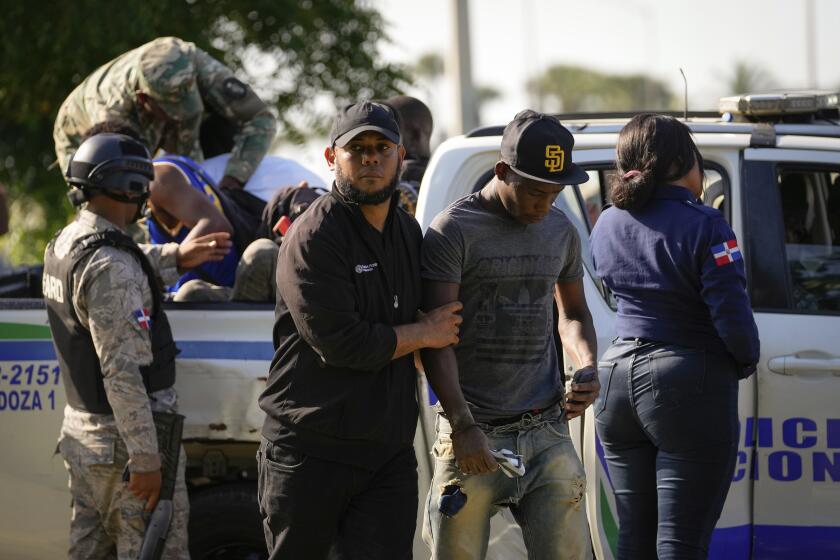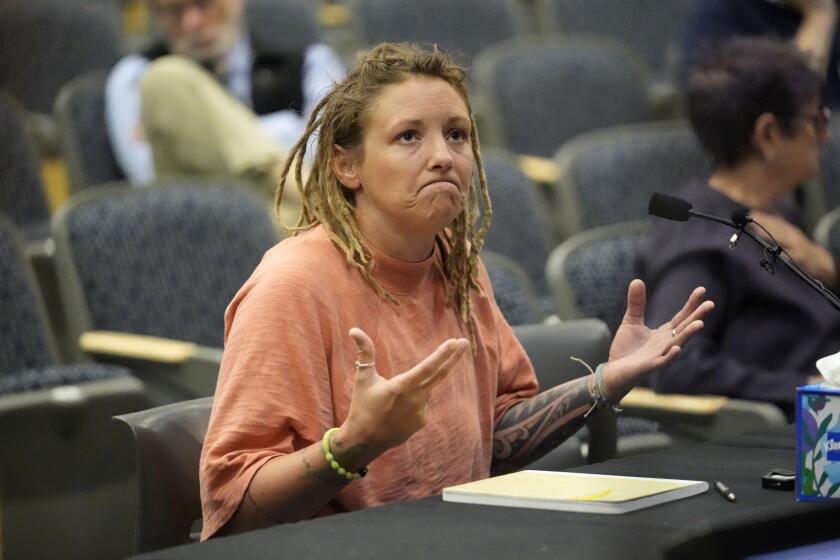Prairie Town Holds Out Hand to Indonesians : Kansas: As many as 3,000 Asians could be living in Garden City. They enjoy acceptance from the town’s longtime residents, including the Hispanics who’ve been there for decades.
For many Indochina refugees, this windy town on the Kansas prairie has been a way station in their journey to a new home.
Here, they begin their earning lives in America. Here, their children learn English and arithmetic and discover the lure of television. And here, they find acceptance from the town’s 24,000 longtime residents, including the Hispanics who’ve been an integral part of Garden City for decades.
“Our community has grown to accept diversity because we’re used to it,” state Rep. David Heinemann says.
Officials estimate as many as 3,000 Asian refugees--Vietnamese, Cambodian, Laotian and Hmong--could be living in Garden City, located about 200 miles west of Wichita, enticed by what one calls the “refugee rumor network.”
Because of the Iowa Beef Packing and Monfort packing plants, which employ a total of about 4,000 people, the town has had a sizable Asian refugee population since the early 1980s. They join the approximately 6,000 Hispanics who arrived decades ago for railroad and field work.
“Tough job, big pay,” Roger Vilaysing, executive director of the Southeast Asian Mutual Assistance Assn., says of the packing plants, where starting wages are $6.80 an hour.
Many Asian families stay for three to five years, until they’ve saved some money, and then move on, often to Texas, Louisiana and California, places with climates similar to Southeast Asia. But some depart for climates as cold as Kansas, if there’s the promise of jobs.
Others, like Georg Anh Nguyen, owner of the Kim Nhung Market, put down roots here.
“I love this job,” Nguyen says as he loads his freezer with fish.
Nguyen worked in a packing plant for four years in the mid-1980s before opening the store, which sells a variety of Asian products, from rice noodles and canned quail eggs to tea sets and Chinese soap.
“The refugee numbers have declined over the years,” said Levita Rohlman of the Catholic Refugee Services, noting that there are fewer refugees leaving Indochina. “(But) we still have a basic refugee community here. We have people constantly coming and people constantly moving out.”
Vilaysing, a former Laotian bomber pilot, says many among the newest wave of Asians don’t come directly from overseas refugee camps but from other resettlement areas, such as California, where jobs for the unskilled are few.
Many are veterans of the prison camps, sometimes called re-education camps, that opened after the fall of Saigon in 1975.
Suong Nguyen and his wife, Nuong, have settled into a sparsely furnished mobile home they share with another couple. They have a television and a VCR and watch Vietnamese movies, or Chinese movies translated into Vietnamese, rented from the Kim Nhung Market.
Nguyen, educated in French schools, served as a captain in the Vietnamese army before the fall of Saigon and spent six years in a prison camp. His wife was an elementary schoolteacher until 1993, when they left Vietnam.
Now, both are employed at the IBP plant, where workers wearing hard hats, earplugs, stainless steel mesh gloves and chain-mail aprons slaughter, skin, gut and trim cattle.
It’s one of the most dangerous jobs in Kansas, and the industry long has relied on immigrant labor, from as far back as the 1906 publication of Upton Sinclair’s novel “The Jungle,” about Polish and Lithuanian workers at Chicago packing plants.
Nuong Nguyen said through a translator that she’d like to learn enough English to give up her job and become a teacher’s aide.
She and her husband study every morning at the adult education center before going to work, and dream of buying a house some day.
In downtown Garden City, at the adult education class, Jessie Palacios paces around the room, giving dictation to about 20 students--mostly Asian--ranging in age from 17 to 65.
Refugees will take three years to learn what she calls “survival English,” and five years before being able to converse without prompting.
“They struggle with it. I know these people are tired,” Palacios said.
In the school district, which is almost half-minority, with Hispanic students outnumbering Asians, children work just as hard.
At 7 a.m., students at Victor Ornelas Elementary start crowding through the doors to eat breakfast or sit on the floor and talk. They speak English, Spanish, Vietnamese, Cambodian, Laotian or Thai. A few speak Hmong, the language of the mountain people in Laos.
“We let them know it’s all right if you don’t speak English,” said Roxie Thompson, director of the English as a second language program. “We pull together.”
When the Asians began arriving, some residents worried about a conflict with Hispanics, but businessman Jack Ramos-Needham, a member of the Kansas Hispanic Commission, says the two groups have little contact, apart from work and school, and that trouble is minimal.
“Some people thought a lot of negative things would happen. What helped is there were sufficient numbers where they effectively had their own community,” Heinemann, the state representative, says of the Asian immigrants.
More to Read
Start your day right
Sign up for Essential California for news, features and recommendations from the L.A. Times and beyond in your inbox six days a week.
You may occasionally receive promotional content from the Los Angeles Times.






